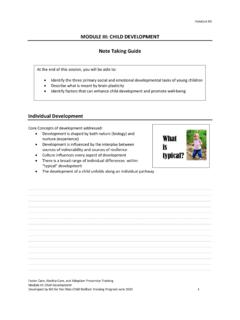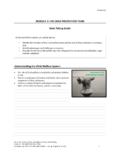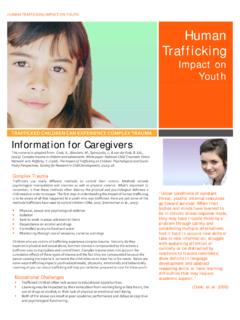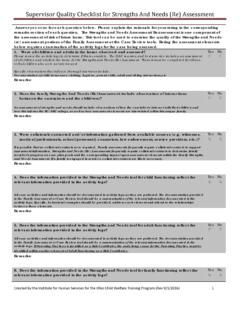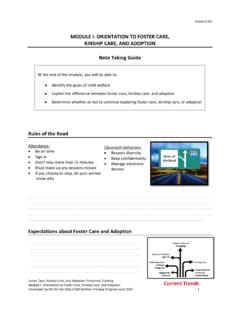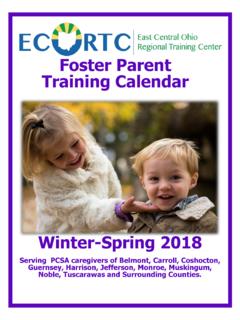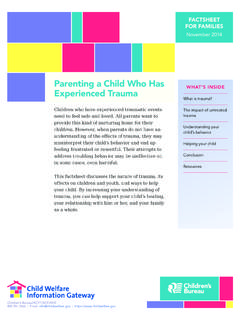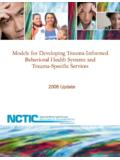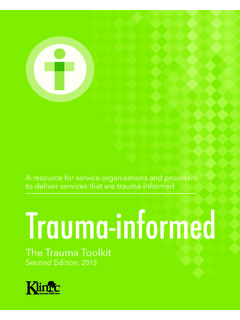Transcription of MODULE VI: MINIMIZING THE TRAUMA OF …
1 Handout #1 Foster Care, Kinship Care, and Adoption Preservice Training MODULE VI: MINIMIZING the TRAUMA of placement Developed by IHS for the Ohio child Welfare Training Program June 2015 1 MODULE VI: MINIMIZING THE TRAUMA OF placement Note Taking Guide The TRAUMA of placement From a child s perspective, placement means: Ruptured relationships New people, routines, and rules Strangers who have authority over them, without their input Labels and stigma _____ What TRAUMA Looks Like _____At the end of this MODULE , you will be able to: Explain strategies you can use to help a child feel emotionally safe Explain how helping the child maintain connections with important people from his past minimizes the TRAUMA of placement Describe the kind of information from a child s history that can help determine appropriate parenting strategies Handout #1 Foster Care, Kinship Care, and Adoption Preservice Training MODULE VI: MINIMIZING the TRAUMA of placement Developed by IHS for the Ohio child Welfare Training Program June 2015 2 _____ Creating Emotional Safety 1.
2 Help them become familiar with the home and community 2. Reassure the child 3. Help the child maintain connections 4. Ask them what makes them feel safe 5. Give them opportunities to express themselves freely 6. Be honest and open in regards to their future 7. Be mindful of transitions and other emotional hot spots (NCTSN, 2007) 8. Know how to address emotional crises _____ _____ Handout #1 Foster Care, Kinship Care, and Adoption Preservice Training MODULE VI: MINIMIZING the TRAUMA of placement Developed by IHS for the Ohio child Welfare Training Program June 2015 3 Importance of Gathering Information about the child Being aware of how a behavior emerged from your child s world is likely to be the best way to know how to respond to that behavior (Hughes & Baylin, 2012). _____ List three ways you will use the information from this training.
3 1. 2. 3. Handout #2 Foster Care, Kinship Care, and Adoption Preservice Training MODULE VI: MINIMIZING the TRAUMA of placement Developed by IHS for the Ohio child Welfare Training Program June 2015 1 1 MODULE VI: MINIMIZING THE TRAUMA OF placement When They First Arrive Judy Qualls (Adoptive Parent, Former Foster Caregiver, and Trainer) This is a brief guide my husband and I have used over the years with our teen girls and boys in an attempt to lessen their sense of feeling alone, out of place, and afraid when stepping into our home and community. STEP 1: Introduce them to the family and give them a tour of the home We always greeting them with a genuine smile, a personal handshake, and an acknowledgment of their acceptance into our family, by saying, We are so happy that you have come. Usually, while the case worker was still present in the home, I would ask one of our trusted senior youngsters to take this newest member of our home on a tour.
4 This provided the opportunity for questions to be answered by someone their own age. The senior girl showed the new girl which room, dresser, and closet would be hers. (Our teen girls tended to share bedrooms and they could decorate as they wished.) She would also be told that each girl had the right to expect that her belongings would not be touched or taken by anyone else without permission. This was one of the non negotiable rules within our home. The tour continued with the new girl being shown the bathrooms, family room, laundry room, etc. Pictures of many smiling young people hung on one wall of our house. I explained to the youngster that some people in the pictures were our birth children, some were our adopted children, and most of them were our foster children. I would then say, I hope one day you will let me put your picture on our family wall.
5 I believe it gave them a connection and an understanding that others had come to this home, lived here, and had moved on. I wanted them to see this home as a place of sanctuary. STEP2: Go over the family rules After the tour, I would ask if there were any questions for me. I would then explain that it was my job, my responsibility, to make certain that everyone was safe in our home. I would say that because none of us knew each other it was important that each member of the family knew what was expected of her but also what each member should be able to expect in being a member of the family. I would give a copy of our 19 Non Negotiable Rules and read through each of them, explaining why we needed each one. I would ask if there were any of these rules that she would feel were too harsh or difficult. Our non negotiable rules essentially cover daily routines such as hygiene, school attendance, and our honoring and respectful treatment of one another.
6 I expressed our hope and desire that she would be happy living with us and that both Jim and I would always be available and open to talk about any concerns or problems they might be experienced. I also let each youngster see and read the Rights of Youth in Foster Care. I maintained a cork bulletin board in the hallway on the main level where the rights, the non negotiable rules, articles from newspapers, magazines, etc., and chore schedule were posted. Handout #2 Foster Care, Kinship Care, and Adoption Preservice Training MODULE VI: MINIMIZING the TRAUMA of placement Developed by IHS for the Ohio child Welfare Training Program June 2015 2 2 I would outline the privileges and rewards that were enjoyed within our family. I would talk about those things that we, as a family, did together such as trips to the seashores of Virginia and Florida, and fun outings to places like Cedar Point and Kings Island.
7 STEP 3: Let the child unpack and settle in After going over the rules, I gave the youngster time to get comfortable in their new room. I have found that most youngsters tend to be very protective of their things and want to do the unpacking themselves. However, if they asked, their roommate would help them settle in. STEP 4: Share a meal Because food always seems to be at the center of fellowship, a warm meal with kid favorites would be next. Mealtime routine and who sits where were easily introduced and modeled by the other youngsters at this time. STEP 5: Give them a driving tour of the community After the meal, we would take a driving tour past the school the youngster would attend and then head into the nearest town. This often included a stop at a local favorite ice cream shop. STEP 6: Introduce the bedtime routine Upon return home, relaxing and bedtime routines followed.
8 Bathing or showering, snack, quiet time in room, and lights out signal the end of that first day at our house. The steps listed above are simply a model of what we did in an effort to forge an easier transition for the youngster coming to stay with us. Certainly, each family can and should develop their own welcome strategy. Because I did not have a parent s knowledge of the youngster s personality and temperament and I did not yet have insight into the personal history of each youngster, my objective was to gain a foundational relationship by learning more about her. I would spend as much time as possible in the proximity of the youngster, and we would participant together in some casual activity that permitted our sharing without a formal sitting down to talk. I also used this time to fill in any blanks she might have about the family or community.
9 Taking this time was invaluable in developing the personal relationship between the teen and me. Giving this time in the very beginning helped set the stage for future times when more serious and difficult discussions would need to take place. I asked a youngster who had been in foster care for six years and had lived in many families how he dealt with all of the moves. He replied very simply, Oh, you get used to it. I don t think a person, much less a youngster, ever gets used to it. It is our responsibility to think about how it would feel if we were placed in their position and do what we can to help them heal. Handout #3 Foster Care, Kinship Care, and Adoption Preservice Training MODULE VI: MINIMIZING the TRAUMA of placement Developed by IHS for the Ohio child Welfare Training Program June 2015 1 MODULE VI: MINIMIZING THE TRAUMA OF placement Emotional Crises Because of the TRAUMA children in care have experienced, and the often ineffective coping skills they have learned, caregivers and adoptive parents may find themselves dealing with a child who is experiencing an emotional crisis.
10 These children are flooded with emotions they have not learned to deal with, and respond reflexively with behaviors they have not yet learned to control. In general, there are three steps to addressing a crisis: Step 1: Establish Safety Protect other children in the home. Children not involved in the conflict should be removed from the scene of the conflict and sent to their rooms. Removing an audience can be an effective tool in de escalating a family crisis. Any objects nearby which could be harmful to the child or others in the family (knives or other sharp objects, objects that could become missiles) should be removed from the proximity of the child in crisis. Many caregivers and adoptive parents choose to store family heirlooms and treasured possessions before a child arrives rather than risk they be damaged during a crisis. Caregivers or adoptive parents may decide to go to their rooms.
